By Prof. Marc W. Herold

Exactly sixty-six years after his German Dornier 217E dive bomber unloaded nearly 4,000 kgs of bombs on the city of Bath, he came back to say sorry. Mr. Willi Schludecker, now 87, one of the Luftwaffe’s most decorated pilots, took part in three raids on Bath on April 25 and 27, 1942. He first saw the city from a height of 1,500 meters just after 11 pm on a clear moonlit night. (1)
The three night-time German raids claimed some 400 civilian lives. (2) Churchill had been rumored to be staying at the Abbey Hotel in Bath, but the German bombs did not hit the hotel. Herr Schludecker, who was twice awarded the Iron Cross, flew the Dornier 217E on 120 raids against targets in England between April and July 1942. The average life-expectancy then of a German pilot was seven raids.
At the time Schludecker and the crews of the other 163 aircraft taking part in the raids upon Bath had no idea that they were exacting revenge for the bombing of the port city of Lübeck in northern Germany on the direct orders of Adolf Hitler. Lübeck had been attacked by 234 Wellingtons and Stirlings that dropped about 400,000 kgs of bombs including 25,000 incendiary devices during the night of March 28/29, 1942. German police reported 301 dead, 3 missing and 783 injured. More than 15,000 people lost their homes. (3) In 1942, Arthur "Bomber" Harris was appointed chief of English Bomber Command and chose Lübeck, an historic medieval city, to test the new Allied program of area or morale bombing. (4) Lübeck, having no military of economic importance, was selected because its timbered, medieval buildings made it a good target for incendiaries. The famed Marienkirche (St. Mary’s Church) was hit on the night March 28/29th.
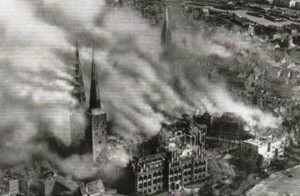
Luebeck, Germany, after RAF bombs, March 1942
(Source: http://www.geschichtsthemen.de/wk2_bilder/bombing/Luebeck1942.jpg)
Sir Arthur Harris went on to firebomb Cologne on May 30/31, 1942 in a raid by over 1,000 RAF aircraft which took off from 52 airfields. The raid hit few factories but caused enormous loss of life, particularly of elderly, women and children (as the men were away at the front). In this single raid on an otherwise mild spring night, nearly 13,000 homes were destroyed, making 45,132 people homeless, 21 churches were demolished and “only” 411 civilians killed. The planes dropped 1,455 tons of bombs on Cologne. (5)
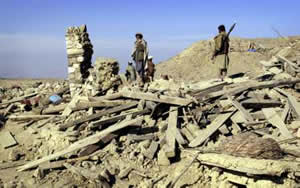
Kama Ado, Afghanistan after U.S. bombs, December 2001
(Source: Photograph by Yola Monakhov at http://www.commondreams.org/headlines01/1204-05.htm)
A comparison of Luftwaffe, Royal Air Force and U.S. Air Force deadliness for civilians can be made by setting Bath, Cologne and Luebeck off against the village of Kama Ado (also called Madoo) which was bombed by U.S. B-52H’s in three waves during the night of November 30/December 1, 2001. Asked about casualties in these Afghan villages, U.S. Major Brad Lowell at the Pentagon said that the locations of the villages matched exactly the site of Taliban command and control structures. On December 1st a Pentagon spokesperson said about that the bombing of civilians near Tora Bora “it just didn’t happen.” (6)
A British reporter for the Sunday Times, John Swain, visited Kamo Ado a couple days after the U.S. strikes. A U.S. official claimed what had been bombed was a military target. Swain wrote,
after a bumpy two-and-a-half hour drive on a rough dirt road, I found nothing in the ruins of Kama Ado that could conceivably link it, or its impoverished inhabitants to Al-Qaeda or terrorism......there was nothing military in the village except for three rocket-propelled grenades in the remains of one home. (7)
The entire village was destroyed in U.S. attacks killing villagers even as they were eating their early morning Ramadan meal at 3:30 A.M. Among those killed was a baby girl born the day before that last night of November 2001. A survivor of Kama Ado, Khalil, 25, put it simply,
the village is no more. (8)
A local village elder, Muhammad Tahir, added,
Civilized countries talk about human rights and then they bomb us. Give my message to the Pentagon: this is our village. This is our only place for living.
Richard Lloyd Parry, Barry Bearak, Marinella Correggia and others reported on these villages in the Tora Bora region "where nothing happened." (9)
On December 16th, Barry Bearak visited the village and wrote
Every house was a ruin of mud-brick and wood, though each had its own eccentricity, like surrealistic sculpture. A table was planted vertically through a collapsed roof. A metal urn was crushed until it was little more than a disc. A basket hung unmolested on the jagged remnant of a wall. An oil can sat erect on a pillow in the middle of a heap. It was not difficult to imagine the power of the bombs. Several dead goats and sheep remained in the wreckage, some beheaded and missing limbs. The scorched and mangled carcass of a red tractor rested on an incline, its tires strewn 100 yards away. Craters were punched into the ground, each a hole large enough to surround a bread truck. (10)
Almost a month after the deadly attack, the Agence France-Presse re-visited Kama Ado. A 2 kms trek off the road and through the fields afforded a view of this tiny village of about 35 homes with a one-time population of 300. (11) Buildings were flattened and a mosque pulverized, turned to dust, along with the people inside. Huge craters pockmarked the two hills. A tractor lay on its side, looking like a toy that had been mauled by a giant hand. The stench of death was overpowering. The first returning survivors had built a burial site up the hill: 50 little mounds were visible. Abdul Hussein, one survivor, said
We have just collected pieces of bodies, chunks of human flesh, and we have put them into the graves. It was not possible to identify them.
They said 60-115 residents perished. The deputy director of the public hospital in Jalalabad, Golodjan Shinwari, was sure of the figure,
Sixty-five bodies of civilians were taken out of the destroyed houses, seven remained under the rubble, and we received 10 persons who had died on the way.
That made 82, the figure I originally reported in my data base (at http://pubpages.unh.edu/~mwherold). Richard Lloyd Parry mentioned 55 dead.
Simple arithmetic reveals that the B-52H’s bombs were far more deadly for civilians than those of the Luftwaffe’s Dornier 217E’s or the RAF bombers. The so-called “precision” bombs dropped upon Kama Ado in the early morning hours of December 1, 2001 were more than ten times deadlier than those delivered by the German Luftwaffe upon Bath in late April 1942 and the RAF upon Luebeck in April 1942 (where the ratio of civilians killed per 10,000 tons of bombs dropped was 7,600) and twenty-six times as deadly to civilians as the RAF raid upon Cologne in May 1942 (where the civilians killed per 10,000 tons of bombs dropped was “only” 2,825):
| Dornier 217Es in 1942 | B-52Hs in 2001 | |
| Number of aircraft in raids | 163 | n.a. |
| Payload capacity per aircraft | 4,000 kgs | 70,000 lbs or 32,000 kgs |
| Tonnage actually dropped | 652 tons | 3-4 bombing waves in which 25 bombs @ at each least 1,000 lbs = total of 11.3 tons was dropped |
| Height from which bombs dropped | ~5,000 feet | Above 30,000 feet |
| Civilians killed | ~ 417 | (55-) 82 |
| Ratio of civilians killed by 10,000 tons bombs dropped | 6,396 | (48,673-) 72,566 |
The graph below compares the deadliness for civilians in four bombing attacks: one by the German Luftwaffe, two by the British Royal Air Force, and one by the U.S. Air Force. Contrary to popular belief (amply nourished by so-called defense intellectuals and corporate media pundits, e.g., William Arkin of the Washington Post), precision bombs as I have tirelessly argued (12), do not spare civilian lives. So-called “precision” weapons have not made the slightest dent in the inexorable trend over the last century of greater numbers of civilian relative to military deaths.
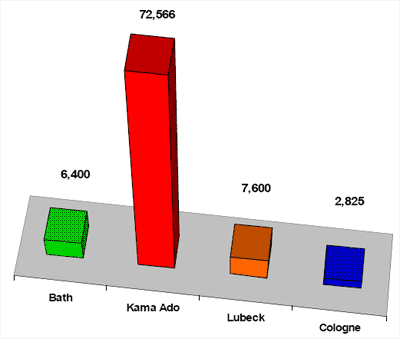
Figure. The Relative Deadliness of Aerial Bombing: Civilians killed per 10,000 tons of Bombs Dropped
The four bombing incidents discussed above should not, however, be extrapolated upon to infer overall or universe estimates of war-time civilian casualties from bombing. Thus, the numbers of civilians killed per 10,000 bombs delivered was: 4,744 in the Allied bombing campaign of Germany during World War II; 809 in the U.S. bombing of North Vietnam during Rolling Thunder; 1,842 during the intense U.S. bombing of Cambodia; and over 2,000 during the three months’ U.S. bombing of Afghanistan. (13)
It is utterly inconceivable that U.S. pilots, who bomb/bombed Afghanistan – like the two below - causing thousands of civilian deaths there, would ever apologize to their victims. Have any of their fellows (like Senator John McCain) apologized for Iraq, Serbia (1999), Panama (1989), Colombia, El Salvador (1980’s), Laos, Cambodia, Vietnam? No, they come from the “chosen nation” clothed in self-righteous, imperial American exceptionalism (and Manifest Destiny). (14) The two pilots mentioned below typify American pilots bombing Afghanistan. U.S. Air Force Lt. Col. Larry Littrell, pilots a B-52H and logged 5,000 hours in combat missions over Afghanistan, dropping thousands of bombs. Littrell says the close air support his massive bomber provides to US (occupation) forces on the ground “should give them a piece of mind that America hasn’t forgotten them, and nothing shows resolve better than a 2,000-pound JDAM bomb.” U.S. Navy pilot, Lt. Ashley, who participated in the early bombing of Afghanistan in an F-14 Tomcat, fondly remembers, “I was smiling: I had dropped my bombs. They hit.” In mid-October 2001, an officer on board the US aircraft carrier, Carl Vinson, described the use of bombs dropped by American B-52H bombers based on the "British" Indian Ocean territory of Diego Garcia. "A 2,000 lb bomb," he said, "no matter where you drop it, is a significant emotional event for anyone within a square mile." (15) “Wall Street”, another B-52 pilot, who flew 19 missions over Afghanistan put it slightly differently, “when they gave us the coordinates, we’d kill whatever they told us to.” (16) Remorse?
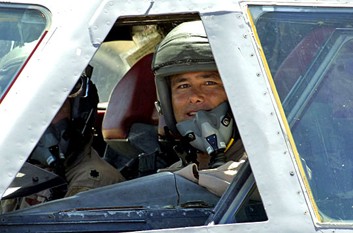
U.S. Air Force Lt. Col. Larry Littrell
(Source: http://www.defendamerica.mil/profiles/apr2006/pr040506ms1.html)
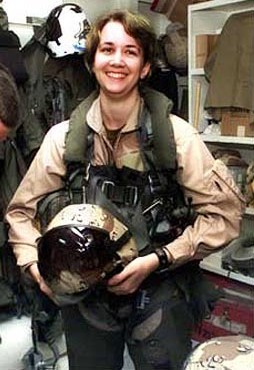
U.S. Navy Lt. Ashley “Mumbles”
(Source: http://www.ctie.monash.edu.au/hargrave/mumbles.html)
In other words, American bombs represent American resolve, a significant emotional event for those near the impact site, and generate smiles – the antithesis of sorrow - for the bombers flying above 30,000 feet. American exceptionalism and alleged moral superiority protects them for any lingering doubts or sorrow. The others kill civilians, Americans do not. Robert Elias listed post-World II instances were the United States bombed and killed civilians:
| Japan (1945) | China (1945–46) | Korea & China (1950–53) |
| Guatemala (1954, 1960, 1967–69) | Indonesia (1958) | Cuba (1959–61) |
| Congo (1964) | Peru (1965) | Laos (1964–70) |
| Vietnam (1961–1973) | Cambodia (1969–70) | Grenada (1983) |
| Lebanon (1983–84) | Libya (1986) | El Salvador (1980s) |
| Nicaragua (1980s) | Iran (1987) | Panama (1989) |
| Iraq (1991–2000) | Kuwait (1991) | Somalia (1993) |
| Bosnia (1994–95) | Sudan (1998) | Afghanistan (1998) |
| Pakistan (1998) | Yugoslavia (1999) | Macedonia (1999) |
Source: cited in Joseph Potter, “War and the Morality of Americans,” LewRockwell.com (May 1, 2008) at http://www.lewrockwell.com/orig9/potter5.html
American exceptionalism has justified armed aggression from Theodore Roosevelt’s ‘Big Stick’ Pax Americana to Clinton-Bush Humanitarian Imperialism. (17) It also allows the United States to disregard international law. (18) The mantra is Support Our Troops and God Bless America.
Footnotes:
1- From Simon de Bruxelles, “German Bomber Pilot Willi Schludecker says: I’m sorry,” The Times (April 25, 2008) at http://www.timesonline.co.uk/tol/news/uk/article3811571.ece. For a photo of the Dornier 217E bomber in 1943, see http://www.fernhurstsociety.org.uk/assets/dornier217Ex.jpg
2- “WWII Pilot to Apologize to City,” BBC News (March 28, 2008) at http://news.bbc.co.uk/2/hi/uk_news/england/somerset/7318709.stm
3- Bruxelles, op. cit.
4- An extraordinary account nowe exists about the Allied terror bombing of German cities, see Jorg Friedrich (translated by Allison Brown) , The Fire: The Bombing of Germany, 1940-1945 (New York: Columbia University Press, 2006), 532 pp. For the specific case of Luebeck, see Lutze Wilde, Bomber geneg Lubeck: Eine Dokumentation der Zerstorung in Lubecks Altstadt beim Luftangriff im Marz 1942 (Lubeck: Verlag Schmidt-Romhild, 1999), 155 pp and 372 photographs
5- “The Thousand Bomber Raids, 30/31/May (Cologne) to 17 August 1942,” at http://www.raf.mod.uk/bombercommand/thousands.html
6- Richard Lloyd Parry, "A Village is Destroyed. And America Says Nothing Happened," The Independent (December 4, 2001) at http://www.commondreams.org/headlines01/1204-05.htm. Richard Parry has subsequently said that this is the article he is most proud of, see http://timesonline.typepad.com/times_tokyo_weblog/afghanistan/index.html. A song by David Rovics about “the village where nothing happened” can be listened to at http://www.soundclick.com/bands/default.cfm?bandID=111310
7- Hasan Suroor, "The Innocent Victims of This War," The Hindu (December 10, 2001) at http://www.hinduonnet.com/2001/12/10/stories/2001121000631400.htm
8- Megan Stack, "Bombed Village Pleads for its Life," Los Angeles Times (December 3, 2001)
9- Parry, op. cit., Barry Bearak, “A Nation Challenged: the Victims; In Village Where Civilians Died, Anger Cannot be Buried,” New York Times (December 16, 2001) at http://query.nytimes.com/gst/fullpage.htmland Marinella Correggia, “Afghanistan: An Epicentre of Social and Environmental Tragedies, A Country of Brave People,” ZNet (February 7, 2002) at http://www.zmag.org/content/TerrorWar/correggia_tragedy.cfm
10- Bearak, op. cit
11- Agence France-Presse, "Terror From the Sky: Survivors Return to the Village That Still Smells of Death," Sydney Morning Herald (December 30, 2001) at http://www.xs4all.nl/~stgvisie/VISIE/world5.html
12- As in Marc W. Herold, “ ‘Collateral Damage’? Civilians and the U.S. Air War in Afghanistan,” in Aftab Ahmad Malik (ed), Shattered Illusions Analyzing the War on Terrorism (Bristol, England: The Amal Press, 2002): 209-246.
13- Data from World War II and Vietnam from James P. Harrison, “History’s Heaviest Bombing,” in Jayne S. Werner and Luu Doan Huynh (eds), The Vietnam War. Vietnamese and American Perspectives (New York: M.E. Sharpe, 1993): 133 and for Cambodia and Afghanistan from Marc W. Herold, “Afghanistan War Produces High Civilians-Killed-Per-Bomb-Ratio,” Cursor.org (January 6, 2002) at http://www.cursor.org/stories/civpertons.htm
14- The entire issue of The American Historical Review vol. 102, no.3 (June 1997) is devoted to an analysis of American Exceptionalism. A critique of American exceptionalism may be read at Ron Jacobs, “American Exceptionalism A Disease of Conceit,” Counterpunch (July 21, 2004) at http://www.counterpunch.org/jacobs07212004.html
15- quoted in Richard Norton-Taylor, “The Return of the B-52s,” The Guardian (November 2, 2001)
16- David Moniz, “B-52 still “BUFF” at 50,” USA Today (April 23, 2002) at http://www.usatoday.com/news/nation/2002/04/24/b-52.htm
17- An excellent analysis of the latter is Jean Bricmont (translated by Diana Johnstone), Humanitariuan Imperialism. Using Human Rights to Sell War (New York: Monthly Review Press, 2007), 176 pp.
18- Nils Andersson, Daniel Iagolnitzer and Diana G. Collier (eds), International Justice and Impunity The Case of the United States (Atlanta: Clarity Press, 2008), 304 pp.



